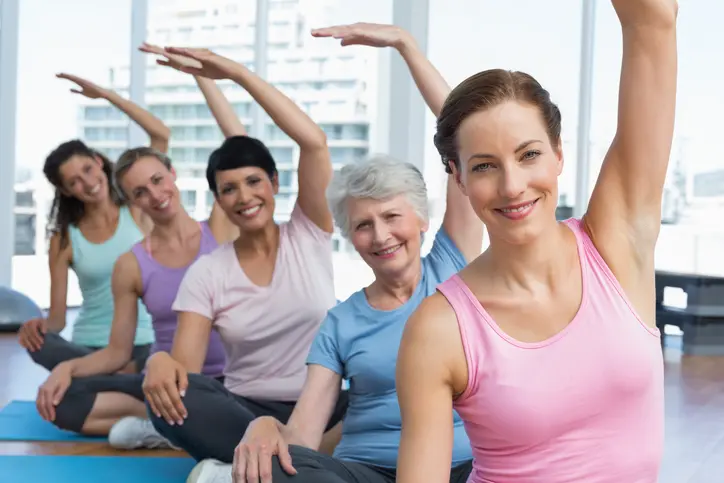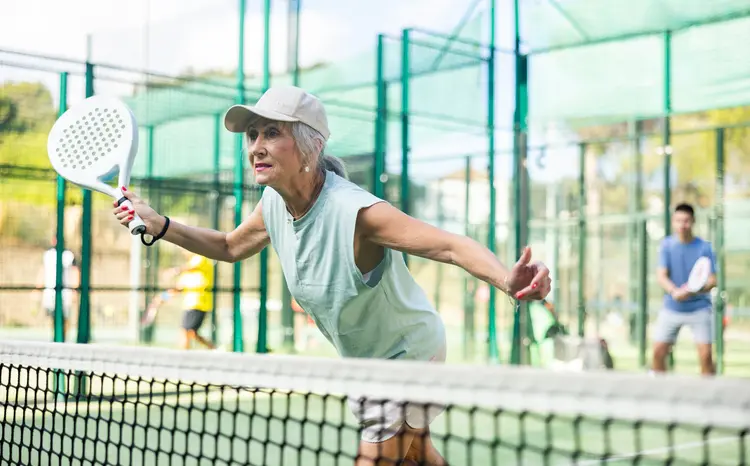Even if you’re an active person, after the age of 40, your body starts to change, and your fitness needs to be switched up as well. Here are the dos and don’ts for changing up your fitness after 40 workout routine to stay healthy as you age.
 When you hit 40, your fitness needs change. At a minimum, consider Canada’s Physical Activity Guidelines recommendation for adults: people 18 to 64 years of age should be active with moderate- to vigorous physical activity at least 150 minutes a week; this works out to just over 20 minutes a day. That said, even if you’re getting enough activity into your lifestyle, there are certain mental and physical needs that shift after the age of 40. With the body experiencing hormonal changes as we get older, along with the fact that there are some health conditions you can lower your risk of by making sure you’re adapting your workouts, you can’t afford to keep doing the same old routine.
When you hit 40, your fitness needs change. At a minimum, consider Canada’s Physical Activity Guidelines recommendation for adults: people 18 to 64 years of age should be active with moderate- to vigorous physical activity at least 150 minutes a week; this works out to just over 20 minutes a day. That said, even if you’re getting enough activity into your lifestyle, there are certain mental and physical needs that shift after the age of 40. With the body experiencing hormonal changes as we get older, along with the fact that there are some health conditions you can lower your risk of by making sure you’re adapting your workouts, you can’t afford to keep doing the same old routine.
That said, when you’re experiencing peri- or post-menopausal symptoms such as hot flashes, sleep issues and mood changes, just maintaining a regular exercise routine will help to mitigate some of the symptoms, says Phaedra Kennedy, a Toronto-based endurance coach.
Age well with a regimen that suits your fitness needs as a woman who’s over the age of 40. Here’s how you should be staying active at this life stage.
 Do include strength training.
Do include strength training.
“The first thing women over 40 need to be doing is to start strength training. You’ve got to lift weight because our muscle mass starts to decline after the age of 30 and once you hit menopause, it starts to decline at an even faster rate,” says Kennedy. Strength training is also especially beneficial at this life stage because it improves your circulation. With improved circulation to your muscles and joints, you can help minimize any inflammation you may be experiencing due to hormonal changes.
Do prioritize rest and recovery in your workout schedule.
Too many women fail to prioritize recovery in the fitness routine. “When you’re burning the candle at both ends and doing all of these hard workouts and not giving yourself the recovery, you’re doing yourself a disservice,” says Kennedy. She said that you won’t be able to build fitness without rest and in fact, you may start to notice changes in your body that you don’t necessarily want to see. Her recommendation for recovery days? She herself typically takes a full day off, but you can go for a walk or do some light yoga. “Active recovery is fine, but don’t go on a four-hour hike. Keep it low intensity,” she says.
Fitness after 40 Must Include weight-bearing exercises.
We lose up to 10 percent bone mass in the first five years after menopause so weight-bearing exercises, which help slow the loss of bone mass, becomes especially important when you’re aged 40-plus. Think aerobic weight-bearing exercises such as running, dancing and even gardening. These types of activities will both help your bones, but the cardio will also help boost your heart health. If swimming or cycling are your preferred workouts, know that these will help with your heart health but that they don’t provide the same weight-bearing benefits.
 Do keep active for the social benefits.
Do keep active for the social benefits.
As we age, our psychological and social wellbeing can be a struggle; often we are dealing with poor health or the death of loved ones, for example. These circumstances can lead to depression and anxiety and feelings of loneliness and grief. By ensuring you maintain an active lifestyle, you improve your relationships and social wellbeing has been shown to help improve your health as you age. “If you have a community or a group of people that you like to train with or run with or whatever your favourite way to work out is, that is so important to just feeling like you belong to something,” says Kennedy, who works primarily with peri- and post-menopausal women.
 Don’t overlook improving your agility and balance.
Don’t overlook improving your agility and balance.
Falls and fractures become a concern as you age, so working on improving and maintaining your agility and balance becomes paramount. The good news is that you don’t have to make it complicated. Kennedy says she often has her athletes do running drills, along with lateral and backward movements since we typically don’t move in those directions. For an everyday balance challenge, she suggests standing on one leg when you’re washing dishes or brushing your teeth as simple ways you can work on your balance on a regular basis. Or get onto the floor and work on getting up from the ground without using your hands.
Do focus on improving your mobility.
As you get older, we start to lose having control over our range of motion and this will impact how your body moves. Think of controlled articular rotations you can incorporate into your daily lifestyle. Kennedy suggests, for one, rotating your wrists and your neck while you’re sitting in front of the TV. For more mobility exercises, check out online resources such as Dr. Kelly Starrett’s the Ready State.


 Do include strength training.
Do include strength training.
 Do keep active for the social benefits.
Do keep active for the social benefits. Don’t overlook improving your agility and balance.
Don’t overlook improving your agility and balance.













